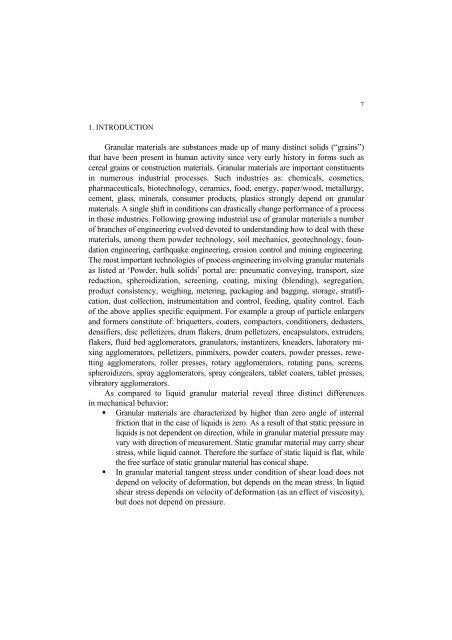Strona 2_redak - Instytut Agrofizyki im. Bohdana DobrzaÅskiego ...
Strona 2_redak - Instytut Agrofizyki im. Bohdana DobrzaÅskiego ...
Strona 2_redak - Instytut Agrofizyki im. Bohdana DobrzaÅskiego ...
Create successful ePaper yourself
Turn your PDF publications into a flip-book with our unique Google optimized e-Paper software.
7<br />
1. INTRODUCTION<br />
Granular materials are substances made up of many distinct solids (“grains”)<br />
that have been present in human activity since very early history in forms such as<br />
cereal grains or construction materials. Granular materials are <strong>im</strong>portant constituents<br />
in numerous industrial processes. Such industries as: chemicals, cosmetics,<br />
pharmaceuticals, biotechnology, ceramics, food, energy, paper/wood, metallurgy,<br />
cement, glass, minerals, consumer products, plastics strongly depend on granular<br />
materials. A single shift in conditions can drastically change performance of a process<br />
in those industries. Following growing industrial use of granular materials a number<br />
of branches of engineering evolved devoted to understanding how to deal with these<br />
materials, among them powder technology, soil mechanics, geotechnology, foundation<br />
engineering, earthquake engineering, erosion control and mining engineering.<br />
The most <strong>im</strong>portant technologies of process engineering involving granular materials<br />
as listed at ‘Powder, bulk solids’ portal are: pneumatic conveying, transport, size<br />
reduction, spheroidization, screening, coating, mixing (blending), segregation,<br />
product consistency, weighing, metering, packaging and bagging, storage, stratification,<br />
dust collection, instrumentation and control, feeding, quality control. Each<br />
of the above applies specific equipment. For example a group of particle enlargers<br />
and formers constitute of: briquetters, coaters, compactors, conditioners, dedusters,<br />
densifiers, disc pelletizers, drum flakers, drum pelletizers, encapsulators, extruders,<br />
flakers, fluid bed agglomerators, granulators, instantizers, kneaders, laboratory mixing<br />
agglomerators, pelletizers, pinmixers, powder coaters, powder presses, rewetting<br />
agglomerators, roller presses, rotary agglomerators, rotating pans, screens,<br />
spheroidizers, spray agglomerators, spray congealers, tablet coaters, tablet presses,<br />
vibratory agglomerators.<br />
As compared to liquid granular material reveal three distinct differences<br />
in mechanical behavior:<br />
Granular materials are characterized by higher than zero angle of internal<br />
friction that in the case of liquids is zero. As a result of that static pressure in<br />
liquids is not dependent on direction, while in granular material pressure may<br />
vary with direction of measurement. Static granular material may carry shear<br />
stress, while liquid cannot. Therefore the surface of static liquid is flat, while<br />
the free surface of static granular material has conical shape.<br />
In granular material tangent stress under condition of shear load does not<br />
depend on velocity of deformation, but depends on the mean stress. In liquid<br />
shear stress depends on velocity of deformation (as an effect of viscosity),<br />
but does not depend on pressure.
















